Resumo
O câncer de pele é a neoplasia mais comum no Brasil, correspondendo a cerca de 30% de todos os tumores malignos. As altas taxas de câncer de pele no Brasil são atribuídas à intensa exposição à radiação ultravioleta (UV) e a características fenotípicas da população, como pele clara e sardas. Um estudo ecológico, baseado em dados do Sistema de Informação sobre Mortalidade (SIM) do DATASUS, analisou óbitos por carcinoma in situ da pele de 2019 a 2023, revelando que a região Nordeste apresentou a maior taxa de óbitos (42,39%), seguida pelo Sudeste (34,01%). A exposição solar crônica, especialmente em idosos, e características fenotípicas aumentam a vulnerabilidade ao CEC. A falta de conscientização e acesso limitado a cuidados de saúde são fatores que elevam a mortalidade. O estudo identificou uma predominância de óbitos entre homens brancos com mais de 60 anos, especialmente acima dos 80, na região Nordeste. Destaca-se a necessidade de estratégias de saúde pública eficazes para melhorar a detecção precoce e o manejo do carcinoma in situ da pele, além de medidas preventivas para reduzir complicações e melhorar a qualidade de vida da população afetada.
Referências
ARAUJO, IZABELLA COSTA et al. Melanoma cutâneo: aspectos clínicos, epidemiológicos e anatomopatológicos de um centro de formação em Belo Horizonte. Revista Brasileira de Cirurgia Plástica, v. 29, n. 4, p. 497-503, 2014.
ARMSTRONG, B. K., & Cust, A. E. (2017). "Epidemiology of cutaneous melanoma and non-melanoma skin cancer." EXS, 108, 89-99.
BICHAKJIAN, C. K., et al. (2016). "Merkel cell carcinoma: Guidelines of care, 2015." Journal of the American Academy of Dermatology, 75(3), 433-462.
BRADFORD, P. T. (2009). "Skin cancer in skin of color." Dermatologic Clinics, 27(4), 453-467.
COUPS, E. J., et al. (2016). "Sun protection and skin self-examination behaviors among U.S. adults." American Journal of Preventive Medicine, 50(5), e117-e123.
FREEDMAN, N. D., et al. (2012). "Alcohol and tobacco use in relation to incidence of melanoma in the NIH-AARP Diet and Health Study." Cancer Epidemiology, Biomarkers & Prevention, 21(7), 1183-1190.
GALLAGHER, R. P., & LEE, T. K. (2016). "Adverse health effects of UV radiation in old age." Photochemistry and Photobiology, 92(2), 185-191.
GELLER, A. C., et al. (2016). "Factors associated with skin examination behaviors among melanoma survivors: A systematic review." Journal of the American Academy of Dermatology, 74(4), 657-667.
GLOSTER Jr, H. M., & NEAL, K. (2006). "Skin cancer in skin of color." Journal of the American Academy of Dermatology, 55(5), 741-760.
GREEN, A. C., & OLSEN, C. M. (2017). "Cutaneous squamous cell carcinoma: An epidemiological review." Journal of Investigative Dermatology, 137(4), 750-757.
HALL, H. I., et al. (2018). "Sun protection behaviors of black and white adults in the United States." American Journal of Preventive Medicine, 55(1), e21-e29.
HAN, J., et al. (2015). "The impact of pigmentation genes on skin cancer risk." Journal of Dermatological Science, 79(2), 162-169.
HOLMAN, D. M., & Watson, M. (2018). "Correlates of intentional tanning among adolescents in the United States: A systematic review of the literature." Journal of the American Academy of Dermatology, 79(6), 997-1005.
HOLMAN, D. M., et al. (2018). "Patterns of sunscreen use and sunburn among US adults." Journal of the American Academy of Dermatology, 78(1), 36-41.
KRUTMANN, J., et al. (2017). "The skin aging exposome." Journal of Dermatological Science, 85(3), 152-161.
LEITER, U., & GARBE, C. (2008). "Epidemiology of melanoma and nonmelanoma skin cancer—The role of sunlight." Advances in Experimental Medicine and Biology, 624, 89-103.
LIMA, M. L., et al. (2016). "Cultural and lifestyle factors influencing skin cancer risk in Brazil." Cancer Epidemiology, 45, 193-198.
LINOS, E., et al. (2017). "A cultural perspective on skin cancer prevention." Dermatologic Clinics, 35(1), 3-9.
NUNES, Daniel Holthausen et al. Incidência do carcinoma de células escamosas da pele na cidade de Tubarão (SC)-Brasil nos anos de 2000, 2003 e 2006. Anais Brasileiros de Dermatologia, v. 84, p. 482-488, 2009.
OLSEN, C. M., et al. (2016). "Lifetime cumulative ultraviolet radiation exposure and basal cell carcinoma risk in young people." Journal of Investigative Dermatology, 136(5), 1007-1013.
REZENDE FILHO, ALTINO VIEIRA DE et al. Perfil epidemiológico de pacientes portadores de câncer de pele atendidos no Hospital Regional da Asa Norte/DF-Brasil. Revista Brasileira de Cirurgia Plástica, v. 35, n. 03, p. 316-321, 2020.
RIBEIRO, A. S., et al. (2017). "Socioeconomic disparities and melanoma: A Brazilian perspective." BMC Public Health, 17, 988.
ROGERS, Luke J. et al. The impact of enhanced recovery after surgery (ERAS) protocol compliance on morbidity from resection for primary lung cancer. The Journal of thoracic and cardiovascular surgery, v. 155, n. 4, p. 1843-1852, 2018.
SANTOS, C. A., et al. (2018). "The impact of solar radiation on skin cancer incidence in Brazil." International Journal of Dermatology, 57(3), 289-294.
SOUZA, F. H., & ALMEIDA, M. F. (2019). "Access to dermatological care and skin cancer outcomes in Brazil." Journal of the American Academy of Dermatology, 80(2), 394-401.
TELFORD, M., & DEY, P. (2015). "Socioeconomic inequalities in cancer survival: A population-based study." Lancet Oncology, 16(2), 207-215.
VISWANATH, K., & ACKERSON, L. K. (2011). "Race, ethnicity, language, and health literacy: Implications for health disparities." Health Communication, 26(2), 109-120.

Este trabalho está licenciado sob uma licença Creative Commons Attribution 4.0 International License.
Copyright (c) 2024 Christiane Karini Rocha, Elisandre Maria Camelo Gomes Natario, Suelen Camila Alves da Silva, Vicenzo Bellincanta Dallazen, Ana Carolina Gazzola Braga

